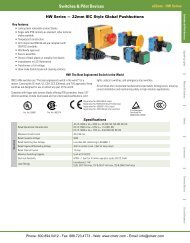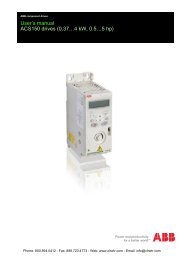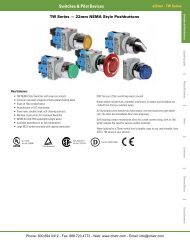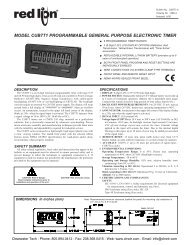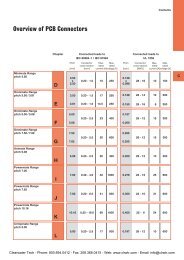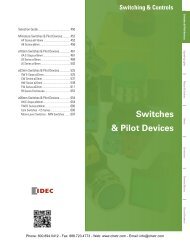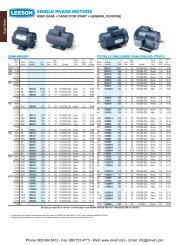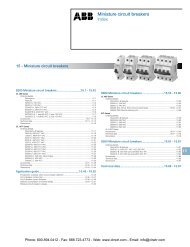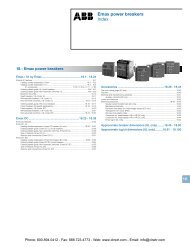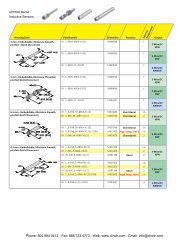IDEC / Datasensor Sensors - Clearwater Technologies, Inc.
IDEC / Datasensor Sensors - Clearwater Technologies, Inc.
IDEC / Datasensor Sensors - Clearwater Technologies, Inc.
You also want an ePaper? Increase the reach of your titles
YUMPU automatically turns print PDFs into web optimized ePapers that Google loves.
<strong>Sensors</strong><br />
General Information<br />
Specifications<br />
Do not operate a sensor under any conditions exceeding these specifi cations.<br />
Do not operate a sensor under current and voltage conditions other than those<br />
for which the individual sensor is rated.<br />
Do not exceed the recommended operating temperature and humidity. Although<br />
sensors are rated for operation below 0°C, this specifi cation does not imply<br />
that performance characteristics will remain constant under prolonged freezing<br />
conditions. Continued exposure and the accompanying frost, ice, dew, and condensation<br />
which accumulate on the optical surface will adversely affect sensor<br />
performance.<br />
To maintain performance characteristics, do not exceed vibration and shock<br />
resistance ratings while operating a sensor. In addition, avoid impacts to the<br />
sensor housing which are severe enough to adversely affect the waterproof<br />
characteristics.<br />
IEC (International Electrotechnical Commission) Ratings<br />
<strong>Sensors</strong> rated IP67 are resistant to moisture when occasionally immersed in<br />
water. <strong>Sensors</strong> rated IP64 through IP66 are resistant to moisture when occasionally<br />
subjected to splashing or when located in the vicinity of turbulent waters.<br />
These ratings do not imply that a sensor is intended for use under continual<br />
high-pressure water spray. Avoid such applications to maintain optimal sensor<br />
performance.<br />
<strong>Sensors</strong> rated IP64 through IP67 are dust-tight and water-tight. For best performance,<br />
avoid using any sensor in an area where it will be subjected to heavy<br />
particle blasts and where dust, water, or steam will accumulate on the optical<br />
surface.<br />
Start-up<br />
Do not test the housing for dielectric strength and insulation resistance, since<br />
the housing is connected to the electronic circuit ground of a sensor. Do not<br />
perform dielectric strength and insulation resistance tests on electrical systems<br />
without disconnecting photoelectric sensors, as such testing may result in damage<br />
to the sensor.<br />
Several lines of sensors, as noted in the individual operation sections, are provided<br />
with an internal circuit to turn an output off for a specifi ed amount of time<br />
upon power-up. This delay is normal; it prevents a transient state when turning<br />
power on.<br />
Optimum Performance<br />
The optical surface of each sensor must be cleaned on a regular basis for<br />
continual superior performance. Use a soft cloth dipped in isopropyl alcohol to<br />
remove dust and moisture build-up.<br />
IMPORTANT: Do not use organic solvents (such as thinner, ammonia, caustic<br />
soda, or benzene) to clean any part of a sensor.<br />
All sensors experience signal inconsistencies under the infl uence of inductive<br />
noise. Do not use sensors in close proximity to transformers, large inductive<br />
motors or generators. Avoid using sensors in direct contact with sources of<br />
excessive heat. Also avoid operation in close proximity to welding equipment.<br />
General Information<br />
Light<br />
Visible light is electromagnetic radiation with a wavelength between<br />
390 and 770nm. White light is composed of all the visible<br />
spectrum components in equal quantity; the predominance of<br />
a specifi c wavelength determines the color of the light. Light Emitting<br />
Diodes (LEDs) are the most common light used in optoelectronics.<br />
Transmission, Absorption, Reflection<br />
When light hits an object three things<br />
take place at the same time: refl ection<br />
(ρ), absorption (α) and transmission<br />
(τ); with parameters and ratios<br />
that vary according to the object<br />
themselves, which are then further<br />
differentiated by material, surface, thickness and/or color. These elements can<br />
be detected using a photoelectric sensor.<br />
Extraneous Light<br />
Bright, extraneous light such as sunlight, incandescent lights, or fluorescent<br />
lights may impair the performance of sensors in detecting color or light.<br />
Make sure that extraneous light does not exceed recommended levels found in<br />
the individual specifi cations sections. When 500 lux is specifi ed, this is equal to<br />
50 footcandles. The average factory illumination is ordinarily below this level,<br />
except in areas where visual inspection is being performed. Only in such brightly<br />
lit areas is incident light of particular concern.<br />
Unwanted light interference can often be avoided simply by making sure that the<br />
optical receiver is not aimed directly toward a strong light source. When mounting<br />
direction cannot be adjusted, place a light barrier between all nearby light<br />
sources and the receiver.<br />
Through-beam <strong>Sensors</strong><br />
With through-beam sensors, the light emitter and receiver are<br />
contained in two different housings that are mounted one in front of<br />
the other. The light beam emitted by the emitter directly hits the<br />
receiver; each object that interrupts the beam is detected. This system is used to<br />
obtain large signal differences<br />
(when the light directly hits the<br />
receiver and when the object<br />
interrupts the beam) with the<br />
highest Excess Gain and the<br />
largest operating distance reaching<br />
up to 50m. These sensors can<br />
operate in the harshest environmental<br />
conditions, such as in the<br />
presence of dirt or dust. The disadvantage is that two units have to be wired (an<br />
emitter and receiver). The through-beam optic function operates typically in dark<br />
mode: the output is activated when the object interrupts the beam between the<br />
emitter and receiver.<br />
It is strongly recommended to avoid using any sensor where it will be continually subjected to elements which<br />
impair performance or cause corrosive damage to the sensor. In particular, avoid strong vibrations and<br />
shocks, corrosive gases, oils and chemicals, as well as blasts of water, steam, dust or other particles.<br />
PLCs Operator Interfaces Automation Software Power Supplies <strong>Sensors</strong> Communication & Networking<br />
<strong>Clearwater</strong> Tech - Phone: 800.894.0412 - Fax: 208.368.0415 - Web: www.clrwtr.com - Email: info@clrwtr.com233





